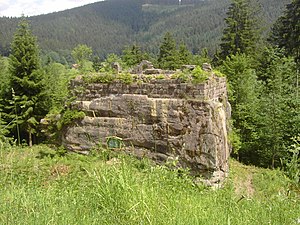Tannenfels Castle (Baiersbronn)
| Tannenfels Castle | ||
|---|---|---|
|
Tannenfels Castle ruins |
||
| Creation time : | around 1100 | |
| Castle type : | Höhenburg, rocky location | |
| Conservation status: | ruin | |
| Construction: | Humpback cuboid | |
| Place: | Obertal | |
| Geographical location | 48 ° 31 '39 " N , 8 ° 18' 1.4" E | |
| Height: | 645 m above sea level NHN | |
|
|
||
The castle Tannenfels is the ruin of a rock castle of the type of tower castle on the right side of the Murg between Rechtmurg and Ilgen Bach .
It stands at 645 m above sea level. NHN high red sandstone rock in the Obertal district of the Baden-Württemberg community of Baiersbronn in the Freudenstadt district .
history
The remains of the tower castle that are visible today were built in the first half of the 13th century. Ceramic finds and an older moat suggest that the castle rock dates back to the 11th century. or early 12th century was occupied with a castle, which was completely cleared during the later rebuilding. The castle was not inhabited for very long, however. It fell victim to a fire as early as the first half of the 14th century, possibly in the course of a military conflict. This could be traced back to three arrowheads from a layer of fire.
No associated nobility is known. A noble family von Tannenfels, who were associated with the ruin, can be located in the Allgäu and therefore has nothing to do with the castle in the Murg Valley. She had property in Aigeltshofen and Rohrdorf (Isny) , among others , and her eponymous Tannenfels Castle was located in the Allgäu across from Eglofs Castle .
According to a note from the 18th century, the castle is said to have been destroyed in a feud between 1371 and 1373 that Count Eberhard der Greiner had undertaken with the diocese and city of Strasbourg . The archaeological and architectural findings speak against it, however, since the castle was destroyed after him.
Say
An underground corridor is said to have once led to the castle, the opening of which was previously still visible in the tower, but is now said to have been buried. In the Württemberg land register of Johannes Öttinger from 1624, due to its location in impassable wilderness, it is assumed that the castle was a robbery castle . Both are typically legendary topoi that are told by many castles.
Archaeological excavations
Due to increasing decay, archaeological excavations were carried out for a total of eleven weeks in 1977/78 by the Karlsruhe branch of the State Monuments Office on the castle. As a result, the building stock should be recorded, the building history and settlement history of the castle rock clarified and a repair prepared. The results were published in the series of publications on medieval archeology in Baden-Württemberg.
Description of the castle
The castle consisted of a tower with an irregular floor plan. Since the location on a large rock, which sloped ten to twelve meters vertically on all sides, offered a natural protection, a wall ring could be dispensed with. The castle grounds were secured by ditches and a natural valley. The small rock in front of it was probably not built on. The entrance could have led over him through wooden stairs. The tower was three to four stories high, with the top floor possibly being made of wood. The bricks made of humpback ashlar had a notch on both sides. From this it can be concluded that they were pulled up with a crane-like hoist. They were connected to one another with lime mortar. There is no indication of the interior layout. A hipped roof or a pent roof is most likely to be used as a roofing .
literature
- Dorothee Rippmann : The investigations on the fir rock near Baiersbronn-Obertal, Lkrs. Freudenstadt, In: Research and reports on the archeology of the Middle Ages in Baden-Württemberg 7. Stuttgart 1981, pp. 371–419
- Max Miller (ed.): Handbook of the historical sites of Germany . Volume 6: Baden-Württemberg (= Kröner's pocket edition . Volume 276). Kröner, Stuttgart 1965, DNB 456882928 .
Web links
- Tannenfels Castle at Burgenarchiv.de
- Reconstruction drawing by Wolfgang Braun
Individual evidence
- ↑ Dorothee Rippmann, The investigations on the Tannenfels near Baiersbronn-Obertal, Lkrs. Freudenstadt, In: Research and reports on the archeology of the Middle Ages in Baden-Württemberg 7. Stuttgart 1981, pp. 371–419
- ^ Günther Bradler: Studies on the history of ministeriality in the Allgäu and in Upper Swabia. Verlag Alfred Kümmerle, Göppingen 1973 (Göppinger academic contributions 50) pp. 317–319.



